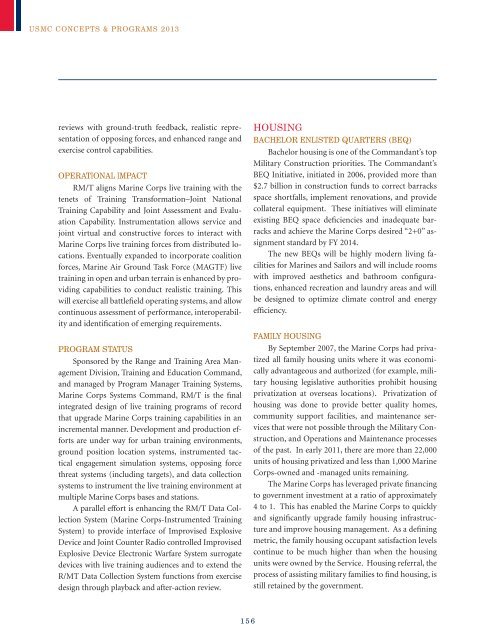USMC Concepts & Programs 2013 - Defense Innovation Marketplace
USMC Concepts & Programs 2013 - Defense Innovation Marketplace
USMC Concepts & Programs 2013 - Defense Innovation Marketplace
You also want an ePaper? Increase the reach of your titles
YUMPU automatically turns print PDFs into web optimized ePapers that Google loves.
<strong>USMC</strong> <strong>Concepts</strong> & <strong>Programs</strong> <strong>2013</strong><br />
reviews with ground-truth feedback, realistic representation<br />
of opposing forces, and enhanced range and<br />
exercise control capabilities.<br />
Operational Impact<br />
RM/T aligns Marine Corps live training with the<br />
tenets of Training Transformation–Joint National<br />
Training Capability and Joint Assessment and Evaluation<br />
Capability. Instrumentation allows service and<br />
joint virtual and constructive forces to interact with<br />
Marine Corps live training forces from distributed locations.<br />
Eventually expanded to incorporate coalition<br />
forces, Marine Air Ground Task Force (MAGTF) live<br />
training in open and urban terrain is enhanced by providing<br />
capabilities to conduct realistic training. This<br />
will exercise all battlefield operating systems, and allow<br />
continuous assessment of performance, interoperability<br />
and identification of emerging requirements.<br />
Program Status<br />
Sponsored by the Range and Training Area Management<br />
Division, Training and Education Command,<br />
and managed by Program Manager Training Systems,<br />
Marine Corps Systems Command, RM/T is the final<br />
integrated design of live training programs of record<br />
that upgrade Marine Corps training capabilities in an<br />
incremental manner. Development and production efforts<br />
are under way for urban training environments,<br />
ground position location systems, instrumented tactical<br />
engagement simulation systems, opposing force<br />
threat systems (including targets), and data collection<br />
systems to instrument the live training environment at<br />
multiple Marine Corps bases and stations.<br />
A parallel effort is enhancing the RM/T Data Collection<br />
System (Marine Corps-Instrumented Training<br />
System) to provide interface of Improvised Explosive<br />
Device and Joint Counter Radio controlled Improvised<br />
Explosive Device Electronic Warfare System surrogate<br />
devices with live training audiences and to extend the<br />
R/MT Data Collection System functions from exercise<br />
design through playback and after-action review.<br />
Housing<br />
Bachelor Enlisted Quarters (BEQ)<br />
Bachelor housing is one of the Commandant’s top<br />
Military Construction priorities. The Commandant’s<br />
BEQ Initiative, initiated in 2006, provided more than<br />
$2.7 billion in construction funds to correct barracks<br />
space shortfalls, implement renovations, and provide<br />
collateral equipment. These initiatives will eliminate<br />
existing BEQ space deficiencies and inadequate barracks<br />
and achieve the Marine Corps desired “2+0” assignment<br />
standard by FY 2014.<br />
The new BEQs will be highly modern living facilities<br />
for Marines and Sailors and will include rooms<br />
with improved aesthetics and bathroom configurations,<br />
enhanced recreation and laundry areas and will<br />
be designed to optimize climate control and energy<br />
efficiency.<br />
Family Housing<br />
By September 2007, the Marine Corps had privatized<br />
all family housing units where it was economically<br />
advantageous and authorized (for example, military<br />
housing legislative authorities prohibit housing<br />
privatization at overseas locations). Privatization of<br />
housing was done to provide better quality homes,<br />
community support facilities, and maintenance services<br />
that were not possible through the Military Construction,<br />
and Operations and Maintenance processes<br />
of the past. In early 2011, there are more than 22,000<br />
units of housing privatized and less than 1,000 Marine<br />
Corps-owned and -managed units remaining.<br />
The Marine Corps has leveraged private financing<br />
to government investment at a ratio of approximately<br />
4 to 1. This has enabled the Marine Corps to quickly<br />
and significantly upgrade family housing infrastructure<br />
and improve housing management. As a defining<br />
metric, the family housing occupant satisfaction levels<br />
continue to be much higher than when the housing<br />
units were owned by the Service. Housing referral, the<br />
process of assisting military families to find housing, is<br />
still retained by the government.<br />
156

















